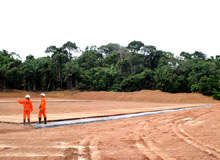
The Urucu-Coari-Manaus pipeline transports natural gas for electricity production in the state of Amazonas, Brazil. The 661km-long pipeline was formally inaugurated in November 2009. It is operated by Transportadora Urucu-Manaus, a subsidiary of Petrobras.
The initial capacity of the pipeline is 4.1 million cubic metres a day. The planned installation of two compressor stations between Urucu and Coari will increase the capacity of the pipeline to 5.5 million cubic metres a day by September 2010.
The pipeline has seven branches, totalling around 140km, which provide gas to several cities, including Coari, Codajás, Anori, Anamã, Caapiranga, Manacapuru, Iranduba and Manaus.
The natural gas will be supplied primarily to thermoelectric power plants that serve the electricity needs of Manaus and municipalities close to the pipeline.
Gradually, replacing the supply of fuel oil with natural gas to thermoelectric power plants in north-eastern Brazil will reduce the carbon dioxide emissions in the region by an estimated 1.2 million tons per year.
The pipeline will facilitate the supply of untapped natural gas production from Solimões Basin, Brazil, which currently has an inefficient transportation facility. It will also be providing natural gas to Breitener Energy's Amazon Power project.
The project lessens the dependency of Brazil on imported energy by replacing oil and gas imports with natural gas. The domestic gas production in Brazil increased from 23 million cubic metres in 2003 to 40 million cubic metres in 2009. Around 10% of the increase was from the Urucu gas field via the pipeline.
The Urucu field is among the significant onshore natural gas field in Brazil. It has reserves of around 98 billion cubic meters and an estimated lifespan of 50 years. Approximately 70% of the workforce was from Amazonas, facilitating regional economic development.
Urucu-Coari-Manaus pipeline construction and development
The work on the Coari-Manaus pipeline started in June 2006. The project was undertaken to transport natural gas from the Urucu oil province to the capital of Amazonas. Construction work was completed in October 2009.
The major focus of Petrobras in 2008 was on the construction and assembly of the pipeline. Due to the lack of a pipeline facility, the gas that was produced along with oil in the Urucu hydrocarbons province was injected back. The Urucu pipeline thus helps substantially in utilising the gas produced in the hydrocarbons province.
The entire pipeline has been developed and classified into three sections, namely section A, section B-1, and B-2.
The project development started with re-developing the existing line carrying LPG from the production facility in Urucu to Coari.
Under section A, a 279km-long line was developed parallel to the existing line to carry natural gas. Section A involved replacing an existing 8in LPG line with a new-build 10in pipeline.
The next stretch of the project was 382km connecting Coari and Manaus. Named section B-1, the stretch links Coari with Anama. This 196km-long section passes through the major flood area covered by the pipeline.
The development of section B-1 required 6,000 floats and barrels. Helicopters were employed to transport individual sections of the pipeline, each weighing 4.5t. A total of 19 directional holes had to be drilled under the river bed.
In the third and last section, B-2, Anama was linked to Manaus. Section B-2 is a 186km-long pipeline of 50cm diameter between Anama and Manaus. Thus, the complete pipeline covered approximately 661km starting from Urucu and finishing in Manaus.
In late 2007, the National Economic and Social Development Bank granted a fund of R$2.49bn for developing the pipeline between Coari and Manaus.
Urucu-Coari-Manaus pipeline contract
The work for section A was carried out by the OAS / Etesco consortium. The contract was valued at R$342.6m.
The contract for the development of section B-2 was awarded to the Skanska consortium Consorcio Gasoducto Amazonia. It was valued at approximately $206m.

